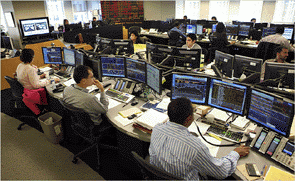
By Kymberley Martin
NZD
The NZD has been on a steady downward path over the past 24-hours, as global risk appetite plummeted. The NZD/USD currently trades around 0.8120, having broken below key support levels.
Yesterday morning the NZ Crown statements to January were published. The Government deficit was wider than expected in the 7 months to January, with the OBEGAL coming in at $4.3b versus $3.8b forecast in the October 2011 pre-election fiscal update. The detail showed some of the miss was related to earthquake related expenses, and some due to underlying pressure on revenue from the slow economic recovery.
The NZD however, came under increasing pressure overnight as global risk appetite was battered (see below). The NZD/USD has now convincingly broken below the steady trading range it had maintained throughout February. Technically there is now little support for the NZD/USD until the 0.8000 level.
Trading in the NZD/EUR was much choppier. However, the NZD/EUR currently trades around 0.6190, having traded around 0.6210 this time yesterday.
The JPY was the strongest performer overnight in the prevailing “risk off” environment. Therefore the NZD/JPY fell heavily from 67.00 to 65.50.
The NZD/AUD cross was knocked lower after the RBA meeting (see below). However, it soon recovered, as the AUD also felt the brunt of risk aversion overnight. The NZD/AUD crept back up to trade around 0.7700 currently.
The day ahead brings NZ wholesale trade data which is unlikely to be market moving. The important release for the cross will be the AU Q4 GDP release at 1.30pm (NZT).
Unless global sentiment is able to stabilise, expect the NZD to face continued downward pressure today.
------------------------------------------------------------------------------------------------------------------------------------------
To subscribe to our free daily Currency Rate Sheet and News email, enter your email address here.
------------------------------------------------------------------------------------------------------------------------------------------
Majors
The USD saw strong demand as a “safe haven” overnight, as risk appetite plunged. It outperformed most of its peers, except a strong JPY. AUD and NZD were amongst the weakest performers.
The USD, that had been drifting upward early in the evening, jumped higher after the release of Q4 Eurozone GDP (-0.3%q/q as expected). Although in line with expectation, it confirmed that the Eurozone is likely already in recession (assuming the current quarter records negative growth also). In addition, the market’s attention returned to Greece.
An 8 March deadline looms for private investors to confirm their participation Greek debt swap offer. The USD index, that traded around 79.30 yesterday afternoon, currently trades above 79.80.
In this backdrop, our risk appetite index (scale 1-100%) fell from 61% to 53%. The Euro Stoxx 50 recorded a 3.40% fall, and the S&P500 is currently down 1.50%. The CRB index of global commodity prices is down 1.40%. The EUR fell from 1.3220 last evening, to trade around 1.3120 currently.
The key beneficiary of the shift in sentiment was the JPY. The JPY has been on a strong losing streak since the start of February, after the Bank of Japan announced further Quantitative Easing measures. However, overnight the JPY regained its “safe haven” appeal. The USD/JPY fell from 81.60 to 80.60.
The AUD has been on a general downward path over the past 24-hours. Yesterday afternoon, the RBA kept rates on hold at 4.25%, as had been widely expected. Its statement was very similar to previous ones, though it noted some improvement in the situation in Europe.
It maintains a mild easing bias, leaving room to cut if conditions “weaken materially”.
It also made mention of the recent rise in the AUD while the terms of trade declined. The AUD dropped a little after the meeting, continuing its descent overnight as global risk appetite evaporated. It currently trades below 1.0550. This takes it below its recent trading range, to the lowest level since end of January.
The key release for the AUD will be 4Q GDP. Growth is expected to remain around the 2.4%y/y level.
Tonight we get German factory orders that provide more colour about the health of the European industrial core. The US ADP employment data will also be released, as a precursor to the all-important Friday US non-farm payrolls data.
No chart with that title exists.
We welcome your comments below. If you are not already registered, please register to comment.
Remember we welcome robust, respectful and insightful debate. We don't welcome abusive or defamatory comments and will de-register those repeatedly making such comments. Our current comment policy is here.